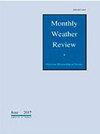2021 年 7 月 11 日造成日本九州南部暴雨的准线性中尺度对流系统的结构和维持情况
IF 2.8
3区 地球科学
Q3 METEOROLOGY & ATMOSPHERIC SCIENCES
引用次数: 0
摘要
2021 年 7 月 11 日,日本九州南部的一个准线性中尺度对流系统几乎保持静止(以下简称静止 QLCS)近 8 小时,造成超过 350 毫米的暴雨。静止的 QLCS 由反向对流组织的多个雨带组成。随着冷池的加强,该系统形成了更广泛的结构,偏向于上升切变一侧。为了阐明造成上切变倾斜的机制,进行了水平网格间距为 250 米的数值模拟,包括降低降雨蒸发冷却率以改变冷池强度的敏感性实验。结果表明,冷池对 QLCS 的组织至关重要,其法线结构主要受低层切变幅度和冷池强度之间平衡的制约,支持将所谓的 Rotunno-Klemp-Weisman (RKW)理论应用于该事件。此外,还研究了在强冷池上方伴随倾斜系统的弱上升气流的成因,利用无弹性方程分析了上升气流的轨迹、垂直动量方程和压力扰动场。结果表明,上升气流在倾斜系统中移动的距离较长,与环境空气的混合程度较高,导致热浮力较小。此外,由于冷池倾斜表面周围的垂直浮力梯度以及冷池前缘周围与气压相关的强水平涡度所造成的动力学效应,上升气流在向下扰动梯度力的作用下减速。本文章由计算机程序翻译,如有差异,请以英文原文为准。
Structure and maintenance of a quasi-linear mesoscale convective system that caused torrential rain in southern Kyushu, Japan on 11 July 2021
A quasi-linear mesoscale convective system that remained nearly stationary (hereafter referred to as a stationary QLCS) for almost 8 h in southern Kyushu, Japan, caused torrential rainfall exceeding 350 mm on 11 July 2021. The stationary QLCS consisted of several rainbands organized by back-building convection. As the cold pool intensified, the system attained a more widespread structure, leaning on the upshear side. To elucidate the mechanism responsible for the upshear tilt, numerical simulations with 250-m horizontal grid spacing were conducted, including sensitivity experiments in which the evaporative cooling rates from rain were reduced to modify the cold pool intensity. Results show that the cold pool is critical to the organization of the QLCS, and the structure normal to it is mainly governed by the balance between the low-level shear magnitude and cold pool intensity, supporting the application of so-called Rotunno-Klemp-Weisman (RKW) theory to this event. The cause of the weak updraft that accompanies the leaning system over the strong cold pool was also investigated, analyzing the trajectories, vertical momentum equation, and pressure perturbation field using the anelastic equation. It is revealed that the updraft travels a longer distance through the tilted system experiencing more mixing with the ambient air, which results in less thermal buoyancy. In addition, the updraft is decelerated by the downward perturbation gradient force owing to the vertical buoyancy gradient around the sloping surface of the cold pool and the dynamical effect caused by the baroclinity-associated strong horizontal vorticity around the cold pool leading edge.
求助全文
通过发布文献求助,成功后即可免费获取论文全文。
去求助
来源期刊

Monthly Weather Review
地学-气象与大气科学
CiteScore
6.40
自引率
12.50%
发文量
186
审稿时长
3-6 weeks
期刊介绍:
Monthly Weather Review (MWR) (ISSN: 0027-0644; eISSN: 1520-0493) publishes research relevant to the analysis and prediction of observed atmospheric circulations and physics, including technique development, data assimilation, model validation, and relevant case studies. This research includes numerical and data assimilation techniques that apply to the atmosphere and/or ocean environments. MWR also addresses phenomena having seasonal and subseasonal time scales.
 求助内容:
求助内容: 应助结果提醒方式:
应助结果提醒方式:


